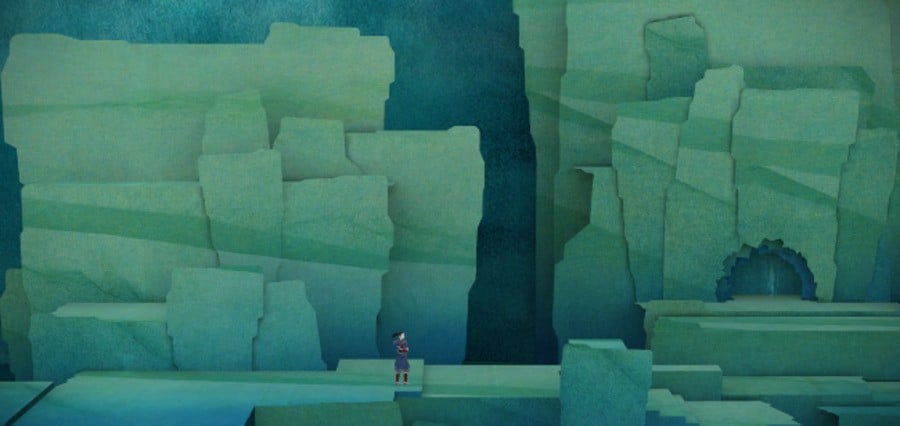
Back in April, we got the exclusive scoop on Tengami's Wii U release. Two months later, we caught up with the game's developer and former Rare coding guru, Phil Tossell, to talk about the Japanese-themed pop-up adventure.
Nintendo Life: We're here with Phil Tossell of Nyamyam Games. You may know him from Rare; he used to work there, he worked on Starfox Adventures which we all loved. But this is the new game. It’s called Tengami. What would you like to tell us about the game? Do you want to give us an overview of the game?
Phil Tossell: So, Tengami is an atmospheric adventure game that places completely inside a Japanese-themed pop-up book, and the idea is that most of what you do is solving puzzles through the use of pop-up, so you’re opening and closing pages, you’re manipulating different mechanisms to make your way through the game.
NL: So, it’s quite a gentle experience?
PT: Yeah, it’s a very relaxed kind of game - something you’d play on your sofa at the end of a long day when you’re feeling tired and you just want to chill out.
NL: What’s the inspiration behind the style of the game? It’s a very, very strong style and you’ve kind of stuck with it throughout. Where did that come from?
PT: So, there are two parts to it – there’s the book, and there’s the Japanese theme that goes with that. I guess we came with the pop-up first which was inspired by touch devices, generally, and also the love of pop-up books that we had when we were children. We thought that the two would marry together really well to make a really interactive experience.
The three of us making it have a love of traditional Japanese arts and crafts, and our artist’s actually Japanese, as well. We thought pop-ups are made of paper, Japan has a great tradition of hand-made papers, so we thought it would make a really unique and interesting style to the game.
NL: Now, I know you’ve built the engine yourself from scratch. What kind of technical challenges did you have with the folding? Because it’s a pure representation of how a pop-up book would work.
PT:Yeah, so every pop-up in the game, you could actually make as a real pop-up with paper and glue. But yeah, we had to learn how to make physical pop-ups first, and then learn the rules for how you actually do that.
NL: So, your office is littered with pop-ups?
PT: It is. Most of them are pretty badly made because we’re not great handcrafters, but we kind of learnt the mechanisms that were involved, and then we had to build a toolset that allowed us to make digital versions of those. In total, that probably took us about a year to go from learning how to make them – effectively becoming kind of paper engineers – and then building the toolset and backgrounds for the game.
NL: Was than an easy process, or were there lots of little challenges? Because I know you like your physics.
PT: (laughs) It was a really long, hard process. I couldn’t really find anything that explained the mechanics of how the folding works. So, I had to work from basic principles, and kind of work out the maths for it which – I’m okay at maths, but it was quite challenging. Once we figured that out, we struggled a little bit to realise what the game would actually be.
Originally, we were thinking it was going to be more of an action-based game, and about nine months in, we kind of sat down and thought “this isn’t really working, we need to rethink this.” And then we kind of refocused on a more relaxed experience, and more of an adventure game than an action game.
NL: Can you tell me a little bit more about the structure of the game? I think you said before that there’s going to be three main sections to the game.
PT: It’s going to be a short-ish game; we’re basically going for a very high quality, focused game with a decent length – two to three hours – and there’s going to be three chapters in the game, which are basically three levels. We’ve got two at the moment- the Forest chapter and the second one is the Ocean one, and the third one we haven’t started on yet.
NL: Okay, well, thanks for talking to us and good luck with the game.
PT: Thank you, thanks for talking to us, too!
Comments 8
The game does sound very promising. I just wish that the length could be a lot longer!
Wow, that is art!
Lost me when he mentioned the length.
looks gorgeous, and i know i'll have to try it, but as said several times before, i too would like to see this go up to about 6 hours initial playthrough...
If, or when, the price is right (5-10 dollars) I'll definitely pick this up.
If they keep that length in mind while pricing ($5-10 sounds good), it looks like yet another must have Indie game coming to the eshop.
These are the gaming experiences I really get excited for. Something a major publisher would not be caught dead releasing on disc.
Not sold yet. We'll see.
Show Comments
Leave A Comment
Hold on there, you need to login to post a comment...